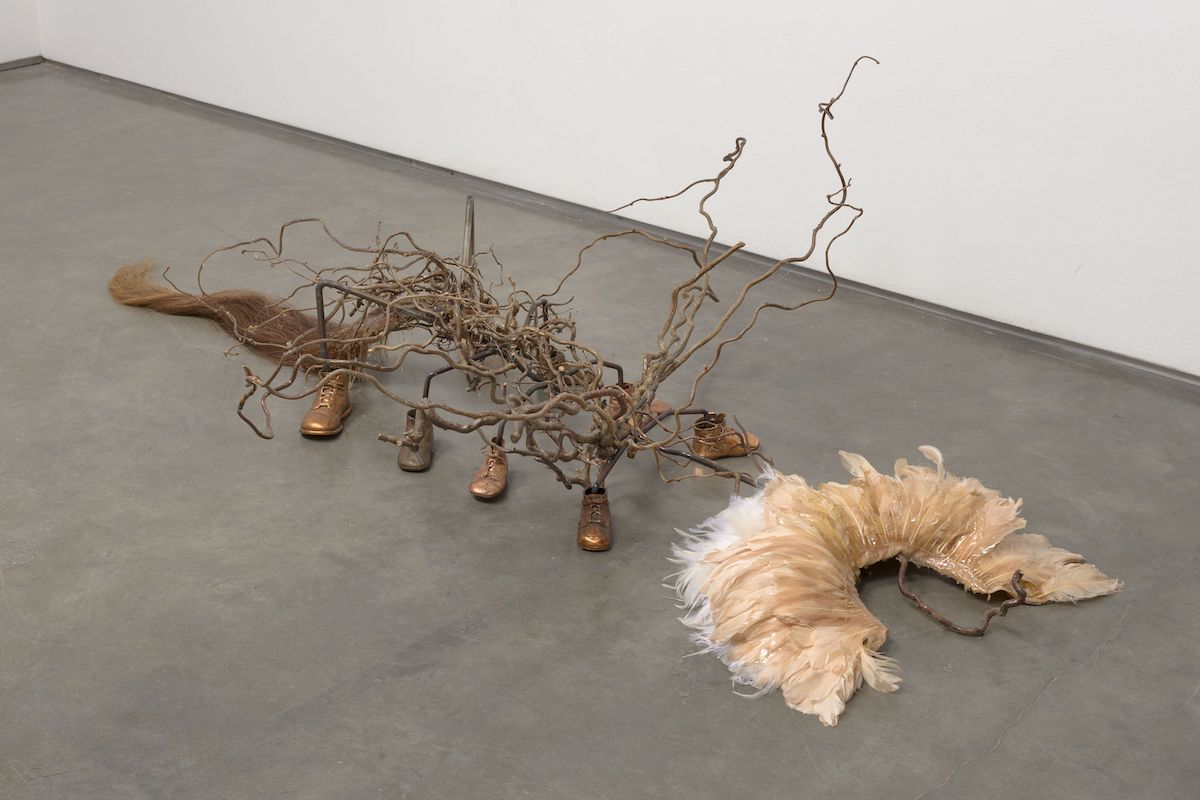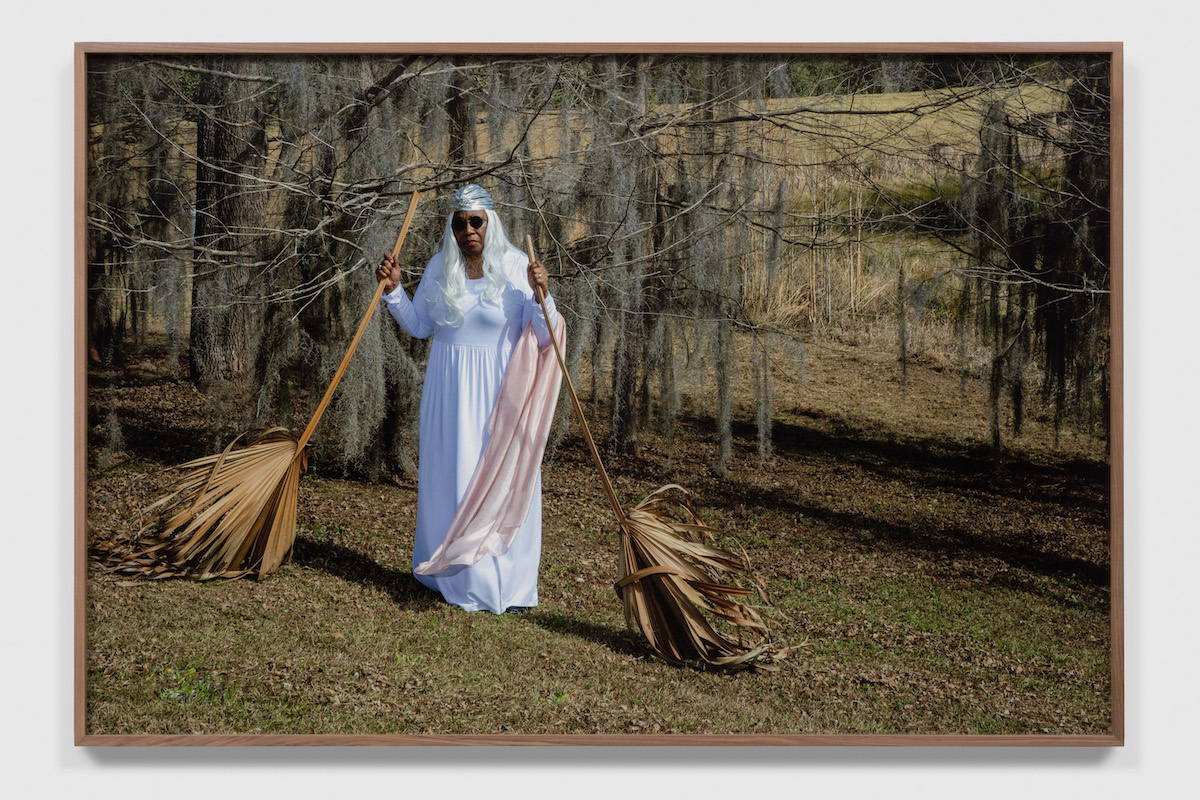Land has been a constant throughout history. We bring to land our personal experiences, and land in turn acts as a witness to the people and events that come and go. For artist Allison Janae Hamilton, land is her most enduring subject. She describes land as a participant in and reflection of histories from the beautiful to the traumatic. Her works are haunting and inspiring, unnerving and captivating as she examines issues of social and environmental justice and unpacks narratives both personal and collective.
Hamilton’s work centers on imagery and folklore of the American rural South. She grew up in Florida, also spending time working on her family’s farm in Tennessee. Her upbringing instilled in her an understanding of issues involved with land. She explained as we connected recently over the phone: “Growing up, I was surrounded by family members, especially elders in my family, who were deeply involved in conversations around land from a political and policy perspective, as well as from an environmental perspective, in particular the changing environment.” From her personal connections and family experiences, land became a “main character” in her work. She continued, “I’m always mining my own experiences and referencing normal conversations from within my family and community.”
Hamilton addresses these topics through photography, film, sculpture and installation. In a photographic series from 2019 titled “Floridawater,” the artist appears, in character, in the Wacissa River. In the hauntingly beautiful images, Hamilton is in a white dress with her body partially submerged in dark water clouded by plants and algae. The viewer sees her from the shoulders down with her head above the water, lending a sense of control as she always retains the ability to breathe.
The Wacissa is part of a river system laden with history. In the first half of the 1800s, enslaved Black people were forced to dig a canal in the dense, swampy system to provide the cotton trade with a path for barges to reach the Gulf of Mexico. Called the Slave Canal, it was never put into use. By the time digging was complete, new railroads filled the transportation needs.

Floridawater I, 2019, archival pigment print, 24 x 36 inches. Courtesy of the artist and Marianne Boesky Gallery, New York and Aspen. © Allison Janae Hamilton.
As a subject for this series and other works in Hamilton’s practice, the Wacissa carries this traumatic history. The series begins with Floridawater I, in which the artist floats calmly, hardly disturbing the river as small bubbles rise and little fish swim by. In Floridawater II, she kicks one leg forward with her toe pointed straight ahead. Her dress, shining in a bright light that penetrates the dark water, appears to slowly descend. The colors and orientation of her body recall Jean Honoré-Fragonard’s Rococo masterpiece The Swing (1767). Hamilton’s photograph is both beautiful and troubling.
The final works in the series are further unsettling as Hamilton stands impossibly still with her feet on a submerged metal grate. Was this space once above water? Is this Florida after a devastating flood? There is a heightened tension between the softly rippling water and the complete stillness of the artist’s body, as if the entire scene is about to burst into motion.
Floridawater builds upon ideas that Hamilton explored in earlier works. “At the time, I was interested in these entities or figures as witnesses who watch over the landscapes,” she explained, “I imagined that they were haints, which is another word for ghosts down South, that took the form of animals or human-like creatures.” The figures connect the past with the present and act as witnesses to the people and events that used the land. Part of this witnessing, Hamilton noted in our conversation, includes events both good and bad. She elaborated, “The history of land is intertwined with so many other histories, like the history of brutal labor practices. Land can reflect traumatic histories while also representing something liberatory, such as healing and ritual practices involving nature. For me, this touches on a relationship between Black cultural practice and Black experiences.”

Installation view, Blackwater Creature II, 2019, mixed media, 13 x 24 x 90 inches. Courtesy of the artist and Marianne Boesky Gallery, New York and Aspen. © Allison Janae Hamilton. Photo credit: Lance Brewer
In her sculptures, Hamilton takes this idea of entities witnessing history further with figures like Blackwater Creature II, an otherworldly being that resembles a giant eight-legged, spindly reptile lying on the ground. The creature has metal feet and limbs, a long hairy tail, a thick band of feathers in place of a head and a torso of jagged sticks. The work feels both contemporary and ancient, existing in the present day, but appearing to be made up of materials from different generations. Hamilton explained that in creating these sculptures, she was interested in exploring the idea of history as something constructed by the powerful. The strange woodland creatures are what she describes as “neutral watchers” that are “in part spiritual, almost like ancestral apparitions or mythological beings.” Indeed, the disparate assortment of materials and objects make it feel as if the sculpture has just climbed out of a swamp with evidence of all the histories it has witnessed sticking to its body over time.
Hamilton brings these spiritual beings into her photography through masks and props. Her latest works, exhibited in the spring of 2021 at Marianne Boesky Gallery in New York, are part portraiture, part landscape photography. They feature Black women standing on the edge of a forest or marsh, perhaps along the Wacissa. The settings are lush and calm, but also eerie and even haunting. The women wear white dresses and adornments like wigs and headdresses. They face the viewer with dark sunglasses covering their eyes and expressions that seem at once stony and soft. In All the Stars Appointed to Their Places (2021), Hamilton’s subject holds two large broom-like palm fronds. Her bright white dress and white wig shine in a mythical, supernatural way.

All the Stars Appointed to Their Places, 2021, archival pigment print, 40 x 60 inches. Courtesy of the artist and Marianne Boesky Gallery, New York and Aspen. © Allison Janae Hamilton.
Hamilton made these works in response to the political climate of the presidential election in 2020. From her home in New York, she watched the news leading up to the South Carolina primary and was alarmed by the way in which New York progressives referred to voters in the southern state as “low information voters.” Hamilton explained, “This didn’t sit with me. These were not low information voters. It felt like an attempt at erasure.” A few months later during the general election and at the height of the pandemic, she was back in northern Florida in an area right across the Georgia border. Being so close to the state, Hamilton saw the outpouring of ads during the Georgia Senate runoff. After the Democratic candidates won, the tone of the messaging suddenly changed away from “low information voters” to celebrating the Black women who were seen as having saved the day.
For Hamilton, the flip-flopping of messaging and unfair generalization of Black women was personal: “These constituents who were being tossed around, dismissed as low information and then celebrated as saviors, they’re like my aunts, my elder cousins, my community, and my family members,” she exclaimed, adding that her new photographs put Black middle-aged women at the center as a “jab at that dismissal” and a way to introduce other important conversations. She said, “When I go home, everyone is talking about issues related to sustainability and the environment because it’s a part of life there. I want the face and the voice of the movement to be closer to reality. The way we’ve come to talk about climate activism, Black women are not the face we are commonly encouraged to think of when we picture an ‘environmentalist’.”

Video still from Waters of a Lower Register, 2020. Courtesy of the artist and Marianne Boesky Gallery, New York and Aspen. © Allison Janae Hamilton. Allison Janae Hamilton’s “Waters of a Lower Register” was commissioned and presented by Creative Time.
Through art and climate activism, Hamilton is claiming space as a Black female environmentalist. Her show at Boesky included a thorough Climate Impact Report and was the gallery’s first carbon-conscious exhibition, in which they tracked the carbon output and donated to permanent, old-growth forest conservation. Hamilton’s works include a monetary climate contribution, a practice Boesky is now implementing with all of its artists. Hamilton often speaks on panels discussing sustainability in the arts and is a member of groups like Artists Commit that share resources on sustainable practices and tips on how to keep galleries accountable, including through the aforementioned Climate Impact Reports.
In December 2020, Hamilton’s immersive five-channel film installation Waters of a Lower Register (2020) was presented in Brooklyn Bridge Park along the East River. The film shows powerful, mesmerizing images of landscapes in northern Florida in the aftermath of a tropical storm and acts as a metaphor for the tumultuous events of 2020. The imagery, personal to Hamilton and her native Florida, presents a stark contrast to the urban environment of New York. And yet, as with all of Hamilton’s work, there is no one way to approach the film. It speaks to countless issues—climate change, social justice, politics—and the viewers bring to the work their own histories. Images of flooded landscapes might have seemed foreign in New York then, but as the climate crisis worsens, storms like Hurricane Ida that hit the city 10 months later are redefining how we see our infrastructure. Hamilton constantly reminds us that our personal experiences and histories are more intertwined than we may think.


